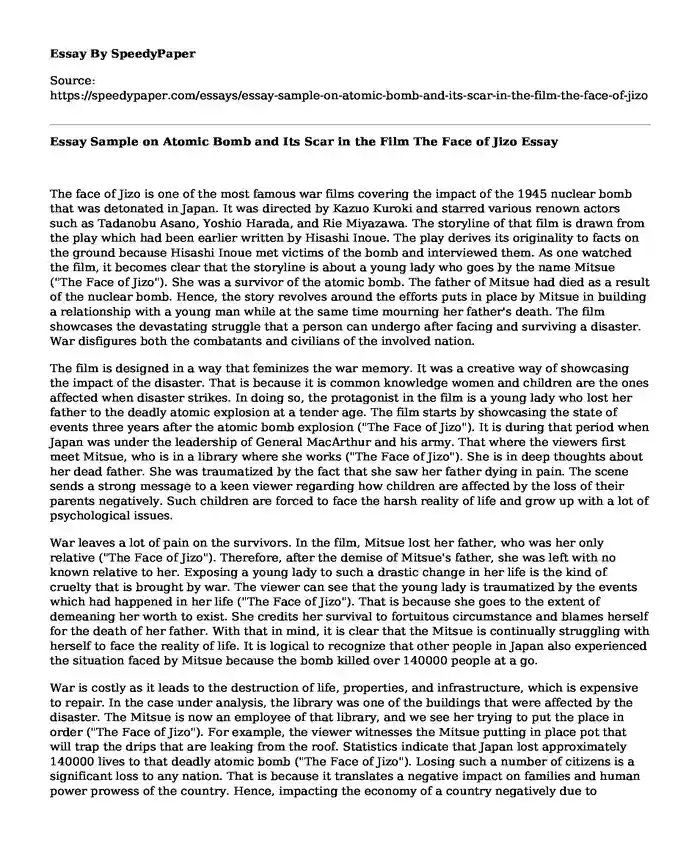The face of Jizo is one of the most famous war films covering the impact of the 1945 nuclear bomb that was detonated in Japan. It was directed by Kazuo Kuroki and starred various renown actors such as Tadanobu Asano, Yoshio Harada, and Rie Miyazawa. The storyline of that film is drawn from the play which had been earlier written by Hisashi Inoue. The play derives its originality to facts on the ground because Hisashi Inoue met victims of the bomb and interviewed them. As one watched the film, it becomes clear that the storyline is about a young lady who goes by the name Mitsue ("The Face of Jizo"). She was a survivor of the atomic bomb. The father of Mitsue had died as a result of the nuclear bomb. Hence, the story revolves around the efforts puts in place by Mitsue in building a relationship with a young man while at the same time mourning her father's death. The film showcases the devastating struggle that a person can undergo after facing and surviving a disaster. War disfigures both the combatants and civilians of the involved nation.
The film is designed in a way that feminizes the war memory. It was a creative way of showcasing the impact of the disaster. That is because it is common knowledge women and children are the ones affected when disaster strikes. In doing so, the protagonist in the film is a young lady who lost her father to the deadly atomic explosion at a tender age. The film starts by showcasing the state of events three years after the atomic bomb explosion ("The Face of Jizo"). It is during that period when Japan was under the leadership of General MacArthur and his army. That where the viewers first meet Mitsue, who is in a library where she works ("The Face of Jizo"). She is in deep thoughts about her dead father. She was traumatized by the fact that she saw her father dying in pain. The scene sends a strong message to a keen viewer regarding how children are affected by the loss of their parents negatively. Such children are forced to face the harsh reality of life and grow up with a lot of psychological issues.
War leaves a lot of pain on the survivors. In the film, Mitsue lost her father, who was her only relative ("The Face of Jizo"). Therefore, after the demise of Mitsue's father, she was left with no known relative to her. Exposing a young lady to such a drastic change in her life is the kind of cruelty that is brought by war. The viewer can see that the young lady is traumatized by the events which had happened in her life ("The Face of Jizo"). That is because she goes to the extent of demeaning her worth to exist. She credits her survival to fortuitous circumstance and blames herself for the death of her father. With that in mind, it is clear that the Mitsue is continually struggling with herself to face the reality of life. It is logical to recognize that other people in Japan also experienced the situation faced by Mitsue because the bomb killed over 140000 people at a go.
War is costly as it leads to the destruction of life, properties, and infrastructure, which is expensive to repair. In the case under analysis, the library was one of the buildings that were affected by the disaster. The Mitsue is now an employee of that library, and we see her trying to put the place in order ("The Face of Jizo"). For example, the viewer witnesses the Mitsue putting in place pot that will trap the drips that are leaking from the roof. Statistics indicate that Japan lost approximately 140000 lives to that deadly atomic bomb ("The Face of Jizo"). Losing such a number of citizens is a significant loss to any nation. That is because it translates a negative impact on families and human power prowess of the country. Hence, impacting the economy of a country negatively due to insufficient resources. Such a scenario sends an essential message to the viewers because it acts as a potent reminder of repercussions attached to war.
Conclusion
In conclusion, when one views the film under analysis keenly, it is clear that it is made up of compelling artistic statements regarding the destruction done by nuclear weapons. Nuclear weapons fall under the category of weapons of mass destruction. The director of the film under analysis did an excellent job in guiding the actors to showcase a profoundly moving performance. Hence, giving the viewer a picture of why war fall in the category of intolerable disasters in whatever angle that one can judge it. With that in mind, it is logical to recommend the drafting and implementation of tighter rules to govern the use of weapons of mass destruction such as atomic weapons. Failure to do so can lead to worse events than what was experienced in Japan.
Work Cited
"The Face of Jizo". Tatsuo Suzuki, 2004.
Cite this page
Essay Sample on Atomic Bomb and Its Scar in the Film The Face of Jizo. (2023, Jan 23). Retrieved from https://speedypaper.com/essays/essay-sample-on-atomic-bomb-and-its-scar-in-the-film-the-face-of-jizo
Request Removal
If you are the original author of this essay and no longer wish to have it published on the SpeedyPaper website, please click below to request its removal:
- Free Essay on Engagement and Assessment of Communities
- Essay Sample on Healthcare Data Shortages
- Healthcare Marketing Essay Sample
- Ethics Paper on Readings: Ethics in the Practice of Public Administration
- Essay Sample about the History of The Royal Slave
- Free Essay Analyzing Washington's Farewell Address
- Paper Example. Introduction to Early Childhood Education
Popular categories





